Morgan
International Hazard
    
Posts: 1694
Registered: 28-12-2010
Member Is Offline
Mood: No Mood
|
|
Bamboo silicate
I was wondering if anyone has tried to waterproof bamboo with waterglass? There's a video here of some non-toxic low vocs substance getting
capillaried up into the bamboo and I suspect sodium silicate might be one of the ingredients. Ideally it would be nice to partially mineralise the
bamboo akin to how petrified wood comes about.
I came across some bamboo today and cut a very tall piece with sections that are 70 mm in diameter. It's still green mostly and leaked some water
from the cut fibrous end standing on end in my garage. So I guess I have to dry it. I recall in the past having a green piece of bamboo about as thick
and over time the sides sadly cracked as it dried out which I'd like to avoid. It's such a pretty material and if you look deep inside one end you can
see a node that looks so flat, as if turned true on a lathe.
https://www.sealitgreen.com/product-category/xtreme-wood-sea...
"Silicate technology to protect and preserve wood was developed in Germany in the 19th century; old methods can be surprisingly efficient, and we
spent a couple of years exploring various wood conservation techniques. We refined the technology and devised our own silicate formula, entirely free
of harmful substances."
http://advantage-environment.com/buildings/traskydd-med-natu...
As an aside, I cut another piece nearby that was dead and had dried naturally in place rooted in the ground . It's perhaps 4 cm in diameter but
holding a meter length of it in your hand it feels like balsa or cork yet very strong. It's uncanny how light it is and no cracks or splitting and
bone dry. Maybe it is best to dry it slowly?
[Edited on 18-11-2019 by Morgan]
|
|
|
Sulaiman
International Hazard
    
Posts: 3692
Registered: 8-2-2015
Location: 3rd rock from the sun
Member Is Offline
|
|
I have no experience, but these guys seem keen
http://www.bamboocraft.net/forums/index.php
CAUTION : Hobby Chemist, not Professional or even Amateur
|
|
|
Morgan
International Hazard
    
Posts: 1694
Registered: 28-12-2010
Member Is Offline
Mood: No Mood
|
|
Thanks for that bamboo link, it looks like a ton of creative stuff. Just now toying with some 23.5 mm deep section and for the heck of it put some
wood alcohol in it and press-fit on a jar lid with a hole in the lid without any real hope to whether a lid would fit the fresh cut bamboo, I just
tried it and the lid snugged on well enough. I just wanted to see if it would fit at all and then figured what the heck give it a try, even though the
proportions are far from idealized, the random length cut when harvesting the bamboo. The flame had a hard time getting down to the pool in this too
long of a cylinder for the diameter. If a jar is too deep the flames can't flicker/dance on the fuel and evaporate enough to sustain combustion. Later
I will just drill a hole in the top of one node so it will be all bamboo and appropriately "wood alcohol".
The base of this plant the nodes are close and the wall thickness increases but higher up on the stalk the bamboo gets much wider on the internal
diameter.
Amazingly the very deep "jar" ran as a bamboo jam jar jet for about 10 seconds. It left an odd speckled burn pattern on the inside.
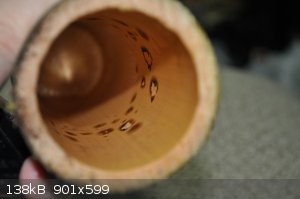 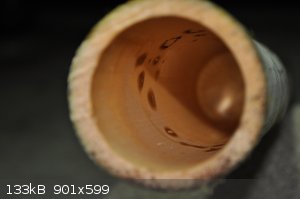 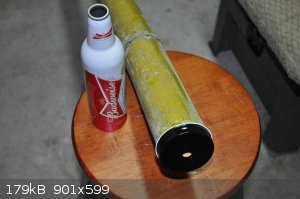 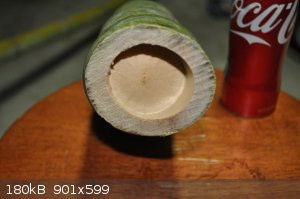 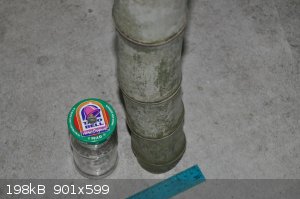 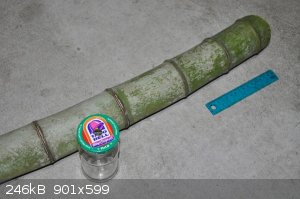
[Edited on 18-11-2019 by Morgan]
|
|
|
Sulaiman
International Hazard
    
Posts: 3692
Registered: 8-2-2015
Location: 3rd rock from the sun
Member Is Offline
|
|
My wife just told me how as a child,
a section of bamboo including two sealed nodes, with a slot cut in it below one of the nodes, was her coin saving box.
Maybe a gift for children ?
Here in Malaysia we have many types of bamboo but I've never personally found a use for it other than as poles.
AFAIK slow drying is less likely to cause cracking than fast drying.
CAUTION : Hobby Chemist, not Professional or even Amateur
|
|
|
rockyit98
Hazard to Others
  
Posts: 283
Registered: 12-4-2019
Location: The Known Universe
Member Is Offline
Mood: no mood is a good mood
|
|
you can get AlCl3 for cheap as water purifying agent. soaking wood in them ,let it suck up the solution and get them dry.then add it to a sodium
silicate solution to neutralize.or the other way around.( 2AlCl3 + 3Na2SiO3 ------->Al2O3 +3SiO2 +6NaCl) in this way we can make faster product
that has no harmful chemicals. maybe you can reduce cracking when drying ,because otherwise you get Na2CO3 which expands as it form from atmospheric
CO2 and as it tends to form Hydrates which also expands. https://en.wikipedia.org/wiki/Sodium_carbonate#Hydrates
not to mention Bicarbonates.
hope this helps
feel free to ask anything.
this topic reminds me a joke. it goes like this.
"preschool teacher- today we are learning about food.can anybody tell me about who eats grass?
random kid- cows, goats,sheep and most people.
preschool teacher- what? may be you do but most people don't.ask your parent to cook something other than grass for breakfast.[smiling]
same random kid- joke's on you sir. because most widely consumed staple food is rice.which is seeds from variety of grass species."
so bamboo is also species of grass.
"A mind is a terrible thing to lose"-Meisner
|
|
|
Morgan
International Hazard
    
Posts: 1694
Registered: 28-12-2010
Member Is Offline
Mood: No Mood
|
|
Thanks for all the ideas and food for thought. I wonder how a paper towel tube would do soaked in AlCl3, dried and then sodium silicate, if it would
form a stronger tube and water resistant?
Are there any examples or photos of bamboo tubes out there that have undergone the process. It would be neat if you could make a glassy bamboo that
was fire resistant and environmentally friendly. Loading it up with aluminum oxide and quartz sounds promising. Don't know about the salt byproduct
though, if it could be leached out perhaps.
Another thing I wondered about is if you could bond aluminum foil to itself to make a hard tube that didn't use epoxy or such but something like a
fire clay that would bond or react with the aluminum, so that it could take a fair amount of heat.
|
|
|
wg48temp9
National Hazard
   
Posts: 784
Registered: 30-12-2018
Location: not so United Kingdom
Member Is Offline
|
|
Quote: Originally posted by Morgan  | Thanks for all the ideas and food for thought. I wonder how a paper towel tube would do soaked in AlCl3, dried and then sodium silicate, if it would
form a stronger tube and water resistant?
Are there any examples or photos of bamboo tubes out there that have undergone the process. It would be neat if you could make a glassy bamboo that
was fire resistant and environmentally friendly. Loading it up with aluminum oxide and quartz sounds promising. Don't know about the salt byproduct
though, if it could be leached out perhaps.
Another thing I wondered about is if you could bond aluminum foil to itself to make a hard tube that didn't use epoxy or such but something like a
fire clay that would bond or react with the aluminum, so that it could take a fair amount of heat. |
I have have been interested in using acetic anhydride to strengthen and water proof wood. It actelates the OH groups which strengthens and reduces
its tendency to absorb water. I think ketene would probably work too and may be an advantage as its a gas.
You are probably interested in this following snip from a paper about sodium silicate and wood: http://www.swst.org/wp/meetings/AM10/pdfs/WS-59%20Peng%20Yuc...
"A wide variety of chemical compounds have been used to modify wood to improve durability.
One of the most extensively studied types over last decade are silicon compounds (De Silva and
Hillis 1980; Furuno et al. 1992; Yamaguchi 2002). Among silicon compounds, “water glass”,
mainly consisting of potassium or sodium silicates or solutions thereof, is the most common. The
process using water glass to treat wood is similar to the typical sol-gel process. In the first step,
the wood products are impregnated with sodium silicate solution. The second step is to
Proceedings of the International Convention of Society of Wood Science and Technology and
United Nations Economic Commission for Europe – Timber Committee
October 11-14, 2010, Geneva, Switzerland
Paper WS-59 2 of 9
precipitate the silicate within the wood structure. One of the methods is to precipitate the silicate
using metal salt solutions such as aluminium sulphate, calcium chloride, barium chloride, borax
(Furuno et al. 1991, 1992). Using this method, Furuno et al. (1992) found that the moisture
excluding efficiencies (MEE) were negative due to the high hygroscopicity of the water glass and
the unreacted metal salts in the lumina of wood cells. Leaching experiments also indicated that
considerable amounts of chemical were washed out when exposed to water (Kartal et al. 2007).
The bending strength of wood was significantly reduced by the water glass treatment while the
dynamic and static moduli of elasticity (MOE) were changed only slightly (Furuno et al. 1992).
The other method used to precipitate the silicate within the wood structure is curing the
impregnated silicate through a suitable drying process. In US Patent 6,040,057, the author
developed a series of appropriate drying processes to dry the water glass treated wood blocks
(Slimark et al. 2000). The author proposed that under the appropriate conditions of heat and
dehydration, sodium silicate undergoes a polymerization process. A water insoluble sodium
silicate was formed on the wood surface. The author provided data to demonstrate the improved
water repellency and fire resistance. The author also claimed that the water glass treatment can
increase the strength, but strength data were not provided in the patent. Another study showed
that strength properties depend on the curing temperature after impregnation"
[Edited on 11/18/2019 by wg48temp9]
I am wg48 but not on my usual pc hence the temp handle.
Thank goodness for Fleming and the fungi.
Old codger' lives matters, wear a mask and help save them.
Be aware of demagoguery, keep your frontal lobes fully engaged.
I don't know who invented mRNA vaccines but they should get a fancy medal and I hope they made a shed load of money from it.
|
|
|
Morgan
International Hazard
    
Posts: 1694
Registered: 28-12-2010
Member Is Offline
Mood: No Mood
|
|
Thanks for the more information. I ran the little bamboo jet again after cutting a portion off the top to make it a little shorter. The curious
leopard spots then formed very near the base of the bamboo as if the erratic vortex of fire was selective somehow to make the spots.
The video is not all that exciting but humble beginnings.
https://www.youtube.com/watch?v=RWiTXy-krHc
And this Wiki I ran across, maybe of interest. Nothing earth shattering.
https://www.wikihow.com/Cure-Bamboo
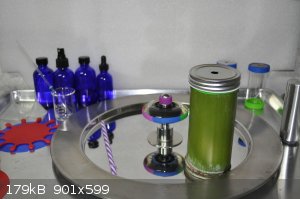 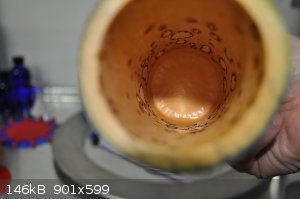 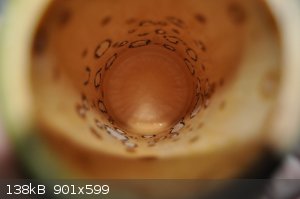
[Edited on 19-11-2019 by Morgan]
|
|
|